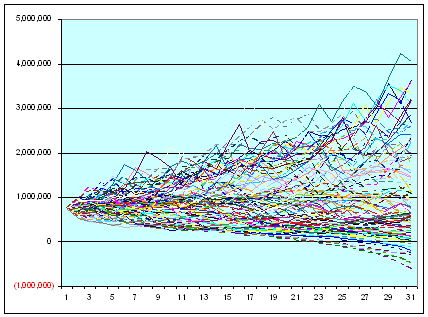A very smart/conservative plan, but no matter how large your 'residual' becomes? Unless leaving a large bequest is a primary goal, at some point I'd think you might take more than 4%. Here's hoping we all have that problem in time...
most folks dont have a clue what the 4% rule even represents. on another forum you and i frequent they are so ignorant of these things that they argue all the time with me about how risky equities are.
i cant get through to them that the 4% rule doesnt represent big gains or even average gains. it represents the worst real returns history ever threw at retirees .
if anything like you said its toooo conservative and to much money usually goes unspent if you follow it to the letter of the law.
the answer the mis-informed give you all the time is "oh im not gambling in equities in retirement " and so they sit in the bank and get zero and complain.
they dont realize they are picking the riskiest investment there is as cash has failed more ofton then anything else.
as michael kitces wrote ,things would have to get to the point that you got under a 2% real return for 15 years to do damage and get that return for 30 years to totaly fail before the 4% rule is in danger.
thats a whole lot worse then now thats for sure.
about the worst group now may be those who retired in 2000 depending on allocations as they are facing the perfect storm.
they retired at a time of low rates,low dividends ,poor market performance and a poor outlook based on valuations.
its still to early though to even pass judgement on them as the danger point is around 15 years in.
i havent retired yet so im in better shape than those in 2000 as there is already just about 13 years of history behind me of crappy years so perhaps i will be closer to an improvement in 2 years when i retire. .
as it looks now ill only need about a 2% withdrawal rate because we have other income so im going to be one of those who break the rule and maintain very low equities allocations because i can meet goal .
but its all going to be dynamic and fine tuned under battlefield conditions as time goes in retirement.


 ) into a separate "slush fund" (that would be invested the same as if in the pot -- the slush fund might just be on [-]paper[/-] electrons) that we could draw from during lean years or for incidentals without worrying about draining the main nest egg ahead of schedule.
) into a separate "slush fund" (that would be invested the same as if in the pot -- the slush fund might just be on [-]paper[/-] electrons) that we could draw from during lean years or for incidentals without worrying about draining the main nest egg ahead of schedule. That takes money.
That takes money.